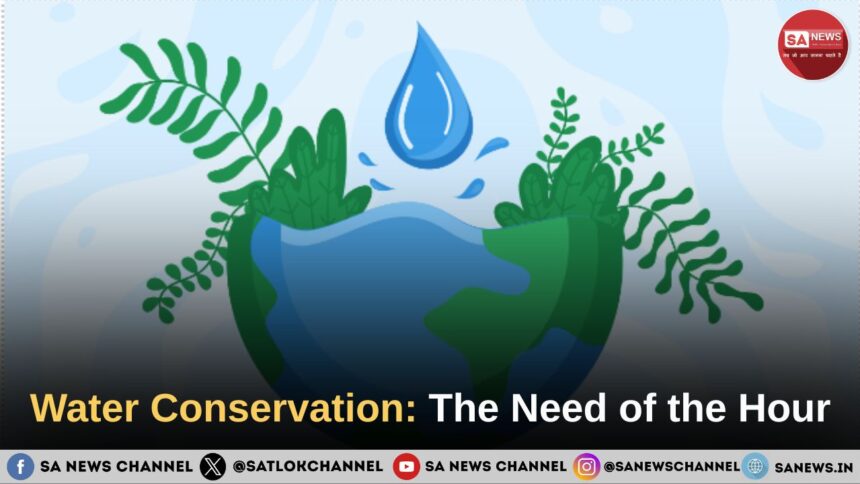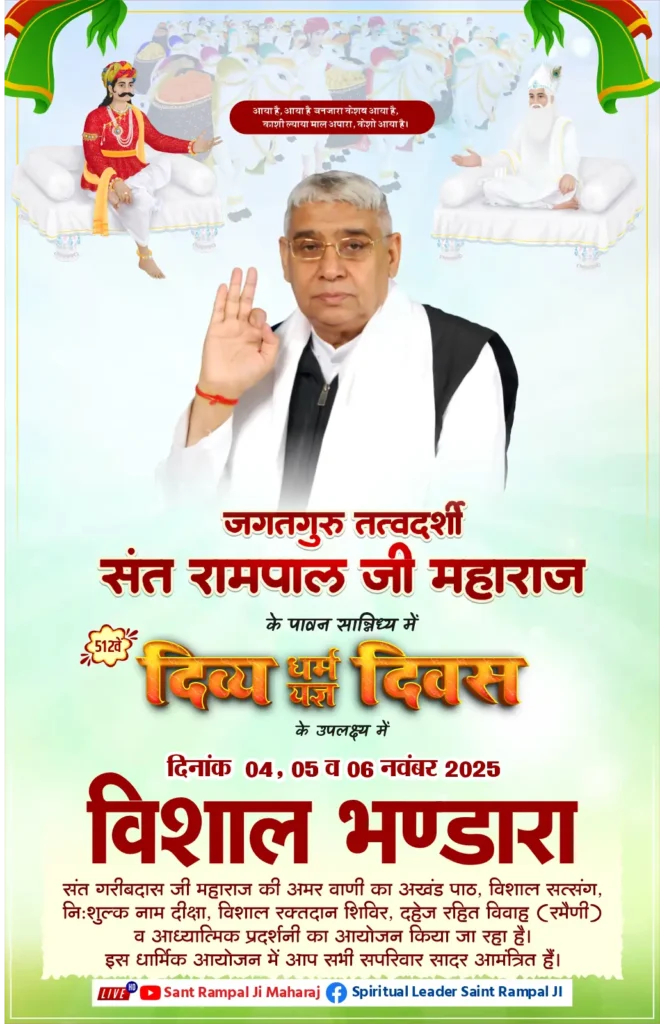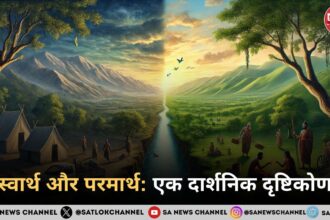Water is the foundation of life, the most precious resource on Earth. Every living organism depends on it for survival. Yet, despite its undeniable importance, humanity has been exploiting water recklessly. From drying rivers to shrinking groundwater tables, the signs of a global water crisis are now visible everywhere.
- The Global Water Crisis
- India’s Water Woes
- Major Causes
- Consequences of Water Scarcity
- Solutions: The Way Forward
- Traditional Wisdom and Indigenous Practices
- Technology and Innovation
- Role of Individuals
- Global Movements and Cooperation
- Role of Sant Rampal Ji Maharaj in Balancing of Earth and Nature
- Conclusion: Every Drop Counts
- FAQs
- 1. What is water conservation?
- 2. Why is water conservation important?
- 3. What causes water scarcity?
- 4. How can individuals help conserve water?
- 5. What is the government’s role?
- 6. What are successful examples in India?
- 7. What happens if we don’t conserve water?
- 8. How does climate change affect water?
- 9. Which technologies help save water today?
- 10. What is the global goal for water management?
In recent decades, the problem of water scarcity has intensified due to population growth, industrial expansion, deforestation, and climate change. The United Nations warns that by 2050, nearly half of the world’s population will live in regions facing severe water shortages.
For a country like India, where agriculture, industry, and daily life all depend heavily on water, this crisis is both environmental and socio-economic. Thus, water conservation is no longer a choice; it is the need of the hour.
The Global Water Crisis
According to the World Health Organization (WHO), around 2.2 billion people globally lack access to safely managed drinking water services. Many regions, from sub-Saharan Africa to parts of Asia and the Middle East, are already facing “water stress,” where demand far exceeds supply.
Climate change has worsened the crisis. Rising temperatures have altered rainfall patterns, causing droughts in some areas and floods in others. Melting glaciers, which supply freshwater to billions, are retreating rapidly. At the same time, industrial and agricultural pollution is contaminating rivers, lakes, and groundwater sources.
Even developed nations are not immune:
1. Cape Town (South Africa) came dangerously close to “Day Zero” in 2018.
2. California (USA) has faced recurring droughts for more than a decade.
3. China and Australia have imposed strict water rationing in many regions.
Water, once considered a renewable resource, is becoming finite due to overuse and mismanagement.
India’s Water Woes
India, home to 18% of the world’s population, has access to only 4% of global freshwater resources — a serious imbalance.
According to NITI Aayog’s Composite Water Management Index (CWMI), around 21 major Indian cities, including Delhi, Bengaluru, Chennai, and Hyderabad, may soon run out of groundwater.
About 600 million Indians already face “high to extreme” water stress, and nearly 200,000 people die each year due to inadequate access to safe water.
Major Causes
1. Overexploitation of Groundwater– Groundwater meets 60% of India’s irrigation needs and 85% of its drinking water demand. However, it’s being extracted faster than it can be replenished. Agricultural states like Punjab, Haryana, and Uttar Pradesh are witnessing steep groundwater decline.
2. Water-Intensive Agriculture– India’s reliance on crops like paddy and sugarcane, which need excessive water, worsens scarcity. Flood irrigation methods waste vast amounts of water that could otherwise be conserved.
3. Urbanization and Industrialization– Cities like Chennai and Bengaluru face acute water crises during summer. Industries such as textiles and tanneries discharge untreated wastewater into rivers, worsening pollution.
4. Climate Change and Deforestation – Erratic rainfall, long dry spells, and rising temperatures have reduced water availability. Deforestation limits groundwater recharge and increases surface runoff.
5. Pollution of Water Bodies– Rivers like the Ganga, Yamuna, and Godavari are heavily polluted with industrial effluents, sewage, and plastic. The CPCB reports that over 350 Indian rivers are unsafe for human use.
Consequences of Water Scarcity
1. Agricultural Decline – Reduced yields lead to food insecurity and farmer distress.
2. Economic Losses – Industries depending on water face disruptions, affecting jobs and growth.
3. Health Problems – Contaminated water spreads diseases like cholera and typhoid.
4. Social Conflicts – Scarcity sparks inter-state disputes, such as the Cauvery water issue.
5. Ecological Damage – Rivers drying up cause biodiversity loss and ecosystem collapse.
Solutions: The Way Forward
1. Rainwater Harvesting
– Collecting rainwater for later use can recharge groundwater and reduce dependence on bore wells. Cities like Chennai and Delhi have made this mandatory.
2. Watershed Management
– Building check dams and percolation tanks helps conserve soil and water together. Villages like Ralegan Siddhi and Hiware Bazar are inspiring success stories.
3. Efficient Irrigation Techniques
– Drip and sprinkler systems save up to 50% of water. Crop diversification toward millets and pulses can further reduce water stress.
4. Reuse and Recycling of Water
– Greywater from households can be reused for cleaning or gardening. Treated wastewater can serve industries or irrigation, as done successfully in Israel.
5. Afforestation and Ecosystem Restoration
– Planting trees and protecting forests help maintain the water cycle. Forests act as natural sponges that store and slowly release water.
6. Awareness and Education
– Campaigns like Jal Shakti Abhiyan and Catch the Rain emphasize the importance of community participation.
7. Policy and Governance
– Strict laws against pollution, incentives for water-saving technologies, and coordinated water-sharing policies are essential for long-term sustainability.
Traditional Wisdom and Indigenous Practices
India’s ancestors developed brilliant water systems — from stepwells (baolis) in Rajasthan to tanks and ponds in the south, and Zing Systems in Ladakh. Reviving these with modern techniques can provide lasting solutions.
Technology and Innovation
Modern solutions include:
1. Smart irrigation systems with soil moisture sensors.
2. Desalination plants for drinking water.
3. Satellite-based monitoring of groundwater.
4. AI models to predict droughts and floods.
These technologies make water management more efficient and predictive.
Role of Individuals
Every drop matters. Simple habits can make a big difference:
1. Turn off taps while brushing.
2. Fix leaks.
3. Reuse RO wastewater.
4. Water plants during cooler hours.
5. Choose local, seasonal food that uses less water.
Global Movements and Cooperation
Water is a shared global resource. The UN Sustainable Development Goal (SDG 6) — “Ensure availability and sustainable management of water and sanitation for all” — aims to secure clean water by 2030.
Achieving it requires global cooperation, technology sharing, and active citizen participation.
Role of Sant Rampal Ji Maharaj in Balancing of Earth and Nature
Sant Rampal Ji Maharaj is playing a divine role in restoring the natural balance of Earth by guiding humanity toward a pure, disciplined, and spiritual way of living as described in the holy scriptures. Through His teachings based on true spiritual knowledge (Satgyan), He emphasizes abandoning harmful practices like animal slaughter, intoxication, deforestation, and wasteful rituals that disturb nature’s harmony.
He inspires His disciples to live eco-friendly lives — adopting vegetarianism, cleanliness, simplicity, and compassion for all living beings. Sant Rampal Ji Maharaj explains that nature remains balanced when humans live in accordance with the Creator’s laws, practicing true devotion (Bhakti) and avoiding sins that pollute the environment and mind alike.
His followers worldwide are spreading awareness about protecting water, air, and soil through spiritual awakening, showing that real environmental balance begins with inner purity and righteous living.
Conclusion: Every Drop Counts
Water is not merely a resource — it is life itself. The global water crisis is a wake-up call reminding us that our planet’s lifeline is under threat.
If we continue this reckless path, future generations may inherit a world where clean water is a luxury.
But if we act now — conserving, reusing, and managing water wisely — we can build a sustainable future. Let’s pledge today to save every drop, because water is not just the need of the hour — it is the need of life itself.
FAQs
1. What is water conservation?
Ans: Water conservation means using water efficiently and preventing wastage through sustainable management, recycling, and careful use.
2. Why is water conservation important?
Ans: Water is vital for drinking, farming, and hygiene. Conserving it ensures food security, health, and ecological balance.
3. What causes water scarcity?
Ans: Overpopulation, pollution, overuse of groundwater, deforestation, and climate change are the main causes.
4. How can individuals help conserve water?
Ans: Turn off taps, fix leaks, install low-flow fixtures, reuse greywater, and practice rainwater harvesting.
5. What is the government’s role?
Ans: The government can enforce water laws, promote conservation programs, and encourage public awareness through initiatives like Jal Shakti Abhiyan.
6. What are successful examples in India?
Ans: Villages like Ralegan Siddhi and Hiware Bazar in Maharashtra are shining examples of successful watershed management.
7. What happens if we don’t conserve water?
Ans: Ignoring conservation can lead to droughts, food shortages, economic loss, and health crises.
8. How does climate change affect water?
Ans: It disrupts rainfall patterns, causes droughts, and accelerates glacier melting — reducing freshwater availability.
9. Which technologies help save water today?
Ans: Drip irrigation, AI-based monitoring, wastewater recycling, and desalination are key innovations.
10. What is the global goal for water management?
Ans: Under UN SDG 6, the goal is to ensure clean water and sanitation for all by 2030 through sustainable management.









